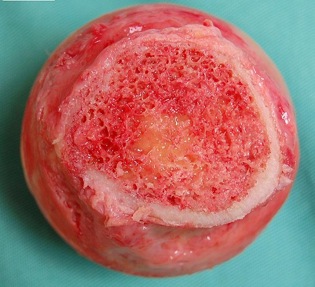
Bone Marrow
last authored:
last reviewed:
Introduction
Bone marrow is the space between the bone cortex. It contains bone trabeculae and blood vessels. It is the primary site of hematopoiesis in adults.
Bone Marrow Structure

Bone marrow in femur head, showing red and yellow
marrow. Used with permission
Red marrow is hematopoietic tissue, while yellow marrow consists mainly of fat cells. All bone marrow is red in newborns, though by adulthood half is replaced by yellow marrow.
Red marrow in the adult is found mainly in the flat bones, such as the hip bone, breast bone, skull, ribs, vertebrae and shoulder blades, and at the epiphyseal ends of the long bones such as the femur and humerus. Yellow marrow is found in the hollow interior of the middle portion of long bones.
In cases of severe blood loss or anemia, the body can convert yellow marrow back to red marrow to increase blood cell production.
Bone marrow contains vascular sinusoids with a network of reticular cells and fibres in close proximity. The marrow synctitium is designed to provide developing cells with a nutrient-rich environment. Cells lining the sinusoids regulate the exit of cells from the marrow.
The stroma of the bone marrow supports hematopoietic stem cells, providing structure and growth factors. Cells include:
- fibroblasts
- macrophages
- adipocytes
- osteoblasts
- osteoclasts
- endothelial cells
<<PIC of SINUSOIDS>>
Hematopoietic Cells
myeloblasts 0-13%
prom 3-12
myelocytes 2-13%
bands/neutrophils 23-45%
eosinophils 0.3-4%
lymphocytes 0-0.4
monocytes
monoblasts 13-38%
myeloid : erythroid precursors is normally 2-4 : 1
Hematopoietic Growth Factors
Bone Marrow Microenvironment
extracellular matrix
The ECM allows attachment of hematopoietic cells and contributes signals controlling proliferation and differentiation. Components include:
- fibronectin
- laminin
- collagen
ECM also regulates HSC location, facilitating interaction with stromal cells.
stromal cells
stromal cells provide physical support for hematopoietic cells and produce growth factors/cell surface proteins that influence differentiation.
- fibroblasts
- osteoblasts
- macrophages
- endothelial cells
- adipocytes
Factors Affective Responsiveness
Anatomy
Function
Cell Biology
Development
Resources and References
Topic Development
authors:
reviewers:
